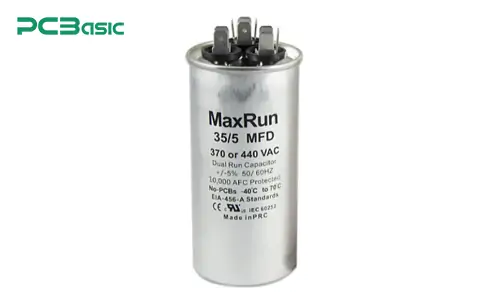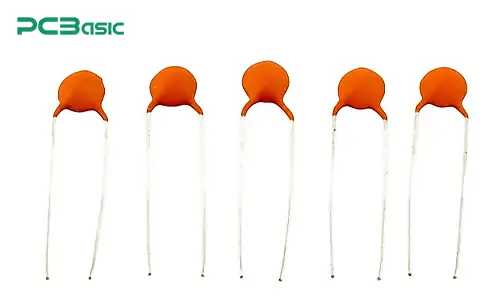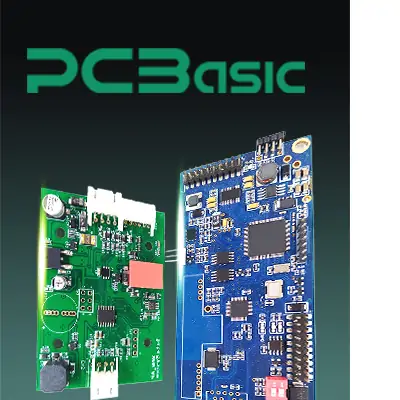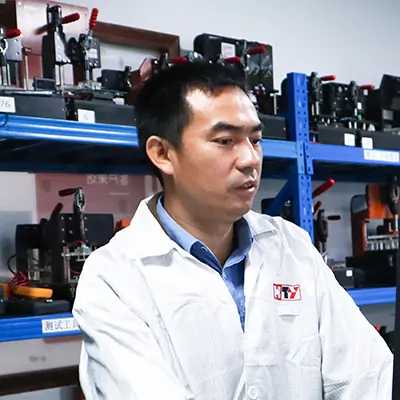

Global high-mix volume high-speed PCBA manufacturer
9:00 -18:00, Mon. - Fri. (GMT+8)
9:00 -12:00, Sat. (GMT+8)
(Except Chinese public holidays)


Global high-mix volume high-speed PCBA manufacturer
9:00 -18:00, Mon. - Fri. (GMT+8)
9:00 -12:00, Sat. (GMT+8)
(Except Chinese public holidays)
HomePage > Blog > Knowledge Base > MFD Capacitors: Everything You Need to Know
Capacitors are a very important component in electronic circuits. They store and release electrical energy in circuits. They play a role in ensuring the reliable operation of circuits in various devices, such as power supplies, audio amplifiers, or industrial control boards. Most capacitors have capacitance markings. In the 1970s to 1990s, MFD was very common on motor starting capacitors, air conditioner capacitors, etc., for example, 5 MFD 370 VAC. As shown in the picture below,

Here, VAC stands for Volts Alternating Current. What does MFD mean? In this article, we will answer questions about MFD capacitors. First of all, let's understand the meaning of "MFD" in a capacitor.
The full name of MFD is "microfarad". It is a unit used to represent the capacitance of an electric capacitor, which is the amount of electric charge that the capacitor can store. In the expression of capacitance units, MFD and μF are actually the same, only with different notations. This is because in the past, printing equipment was not convenient to use the Greek letter "μ", so some manufacturers were accustomed to using "MFD" instead of "μF". In short:
MFD = µF = microfarad, 1 µF = 10⁻⁶ F.
Generally, the larger the MFD (µF) value is, the more energy the capacitor can store and release. Now, µF (microfarad) is the internationally accepted and standardized notation. While MFD is an early or regional old notation that only appears in specific situations. Today, we can still see labels such as 5 MFD, 7.5 MFD, and 10 MFD on some capacitors, like capacitors on air conditioning compressors, electric fans, and blowers, etc.
MFD is a unit representing the capacitance of a capacitor and does not indicate the structure or material of the capacitor. An MFD capacitor refers to a capacitor whose capacitance is marked in microfarads (µF). MFD capacitors are not a new type of capacitor. Essentially, MFD capacitors are exactly the same as µF capacitors, with the only difference being the way they are labeled. Common applications of MFD capacitors include:

Motor starting and running circuits - such as in air conditioners, fans, and compressors;
Power supply filtering - to smooth out fluctuations in DC voltage;
Audio and lighting systems - to suppress noise and stabilize power;
Electronic circuit boards - for signal coupling and decoupling.
MFD capacitors have good stability and energy storage characteristics and are widely used in both household and industrial fields.
After understanding the meanings of MFD and MFD capacitance, let's further learn how to read the parameter markings on the capacitor shell. Why do we need to learn these markings? Because mastering them can help us quickly and accurately select the appropriate model when repairing or replacing it.
For example:

7.5 MFD 440VAC ±5% 50/60Hz
Its meaning is:
Capacity: 7.5 MFD, which means the capacitance value is 7.5 microfarads (µF);
Rated Voltage: 440 VAC, indicating that this capacitor can operate safely within the maximum 440 volts of alternating current;
Tolerance: ±5%, meaning the actual capacitance is allowed to fluctuate within the ±5% range of the nominal value;
Frequency: 50/60Hz, suitable for common alternating current frequencies.
Isn't it simple? However, when replacing the capacitor, we need to pay attention to the following points regarding the capacitor's markings:
1. Capacitance (MFD/µF) matching
When replacing capacitors, we should use capacitors of the same capacitance value. If they are not matched, for example, if a 10 MFD capacitor is used instead of a 7.5 MFD one, it is very likely to cause unstable motor operation or power deviation.
2. Voltage (VAC/VDC) should be the same or higher. Never use a capacitor with a lower withstand voltage.
3. Pay attention to distinguish between AC and DC capacitors
VAC indicates capacitors used for AC power (such as motor running capacitors).
VDC indicates capacitors used for DC power (such as electrolytic capacitors).
4. Pay attention to check polarity
Electrolytic capacitors have positive and negative poles. They must not be reversed; otherwise, they will be damaged.
5. Pay attention to temperature and tolerance
In high-temperature environments, we should choose capacitor models with high temperature resistance (105°C). This way, the stability will be better and the lifespan will be longer.
Earlier, we have already mentioned that MFD capacitors are not a special type of capacitor. They are simply capacitors whose capacitance is measured in the MFD unit. In fact, there are many types of capacitors that are measured in the MFD unit. Next, what we are going to introduce are several common capacitors that are measured in the MFD unit.
|
Capacitor Type |
Key Characteristics |
Polarity |
Capacitance Range |
Voltage Rating |
Typical Applications |
|
Electrolytic Capacitors |
Compact size, high capacitance, ideal for DC circuits; reverse connection or AC use can cause heating, leakage, or explosion |
Polarized (positive and negative terminals) |
1 MFD – several thousand MFD |
Typical: 10 MFD 50V, 47 MFD 25V, 100 MFD 63V |
DC power supplies, voltage filters, audio amplifiers, LED drivers, power control boards |
|
Motor Run Capacitors |
Operate continuously; withstand high temperature and voltage; improve motor efficiency and power factor |
Non-polarized |
3 MFD – 80 MFD |
Typical: 5 MFD 440VAC, 7.5 MFD 370VAC, 10 MFD 450VAC |
Fans, blowers, air conditioner compressors, washing machines |
|
Motor Start Capacitors |
Provide high torque during motor startup; operate only for a few seconds; automatically disconnected after startup; prolonged use may cause overheating or damage |
Non-polarized (AC use only) |
100 MFD – 400 MFD |
Typically 250VAC – 450VAC |
Air conditioners, pumps, refrigerators, power tools |
|
Film Capacitors |
Low loss, high insulation resistance, stable and long-lasting; capable of handling high surge current without degradation |
Non-polarized |
1 MFD – 10 MFD |
Up to 600V or higher |
Lighting circuits, filters, snubber networks, power factor correction, industrial control systems |
Regardless of the type, all capacitors are measured in terms of MFD (µF, microfarad), which represents the capacitance unit. These capacitors are collectively referred to as MFD capacitors.
Capacitors are important components in electronic devices. Therefore, to ensure the stable and normal operation of the equipment, choosing the correct capacitor is essential. Here are some suggestions we provide. When faced with various capacitors with different markings, we can make judgments from the following five aspects.
1. Let's start with the capacitance. The capacitance must be matched because capacitance is the most important parameter of an electric capacitor. It determines the amount of charge that the capacitor can store. When replacing, always follow the principle of "replacing with the same capacity value" (we have already mentioned this earlier).
2. Look at the rated voltage. The rated voltage indicates the maximum voltage that the capacitor can safely withstand during long-term operation. In high-voltage or high-temperature conditions, we must not choose a model with low withstand voltage because doing so is very likely to cause dielectric breakdown, leakage, or explosion. We can choose a model with higher withstand voltage, which can also enhance the electrical safety margin.
3. Consider the environmental factors used. In different scenarios, we should select the corresponding structure and material of the capacitor based on factors such as temperature, humidity, air pressure, and vibration because the stability and lifespan of the capacitor are largely influenced by environmental conditions.
|
Environmental Condition |
Recommended Capacitor Type |
Purpose / Description |
|
High-temperature or outdoor environment |
High-temperature rated type (e.g., 105 °C grade) |
Prevents capacitance degradation caused by heat aging |
|
Humid or condensation area |
Sealed type or oil-filled capacitor |
Prevents moisture ingress that may cause breakdown or corrosion |
|
Oily or dusty environment |
Capacitor with protective coating or metal casing |
Enhances mechanical strength and protection performance |
4. Consider the type of circuit. The selection of capacitors should match the type of the circuit they are in. Otherwise, it is very likely to cause abnormal circuit functions or damage to the components.
5. Pay attention to the polarity and installation direction of the capacitors. Especially for electrolytic capacitors, we must strictly pay attention to the marking of the positive and negative poles. Once the installation direction is reversed, it is very likely to cause the decomposition of the internal electrolyte. Even if it is a minor failure, the capacitor may fail, and in the worst case, it may explode and catch fire. This point must be paid extremely close attention to.
MFD capacitors actually refer to microfarad (µF) capacitors and are widely used in various electrical and electronic systems. When choosing or replacing capacitors, it is always necessary to match the capacitance value (MFD/µF) and ensure that the rated voltage is not lower than the original specification. By strictly adhering to this principle during use, we can largely guarantee the stable operation of the equipment and extend its service life.
Time is money in your projects – and PCBasic gets it. PCBasic is a PCB assembly company that delivers fast, flawless results every time. Our comprehensive PCB assembly services include expert engineering support at every step, ensuring top quality in every board. As a leading PCB assembly manufacturer, we provide a one-stop solution that streamlines your supply chain. Partner with our advanced PCB prototype factory for quick turnarounds and superior results you can trust.
 About PCBasic
About PCBasic

Assembly Enquiry
Instant Quote
Phone contact

+86-755-27218592
In addition, we've prepared a Help Center. We recommend checking it before reaching out, as your question and its answer may already be clearly explained there.
Wechat Support

In addition, we've prepared a Help Center. We recommend checking it before reaching out, as your question and its answer may already be clearly explained there.
WhatsApp Support

In addition, we've prepared a Help Center. We recommend checking it before reaching out, as your question and its answer may already be clearly explained there.
